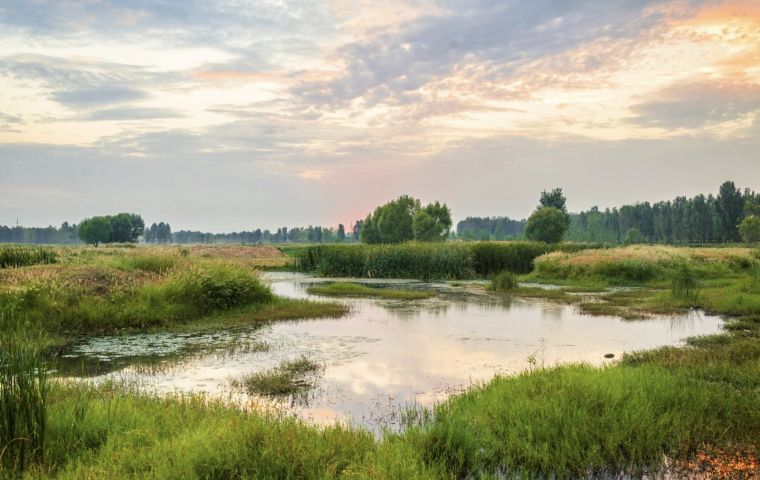MercoPress. South Atlantic News Agency
Revive and restore Wetlands
 Though they cover only around 6 per cent of the Earth’s land surface, 40 per cent of all plant and animal species live or breed in wetlands.
Though they cover only around 6 per cent of the Earth’s land surface, 40 per cent of all plant and animal species live or breed in wetlands. On 30 August 2021, the UN General Assembly proclaimed 2 February as World Wetlands Day to raise awareness of the urgency of reversing the accelerating loss of wetlands and to promote their conservation and restoration. The day marks the date of the adoption of the “Convention on Wetlands of International Importance” held in 1971 in the Iranian city of Ramsar on the shores of the Caspian Sea.
Through the designation of protected areas, the implementation of effective policies, and the sharing of knowledge, the Convention enables countries to take measures to protect their wetlands and to use them wisely. Adopted by 172 countries, each country joining the Convention must designate at least one wetland to be included in the List of Wetlands of International Importance
Revive and restore degraded wetlands. Wetlands are ecosystems where water is the primary factor controlling the environment and the associated plant and animal life. A broad definition of wetlands includes both freshwater and marine and coastal ecosystems such as all lakes and rivers, underground aquifers, swamps and marshes, wet grasslands, peatlands, oases, estuaries, deltas and tidal flats, mangroves and other coastal areas, coral reefs, and all human-made sites such as fishponds, rice paddies, reservoirs and saltpans.
These lands are critical to people and nature, given the intrinsic value of these ecosystems, and their benefits and services, including their environmental, climate, ecological, social, economic, scientific, educational, cultural, recreational and aesthetic contributions to sustainable development and human wellbeing.
Though they cover only around 6 per cent of the Earth’s land surface, 40 per cent of all plant and animal species live or breed in wetlands. Wetland biodiversity matters for our health, our food supply, for tourism and for jobs. Wetlands are vital for humans, for other ecosystems and for our climate, providing essential ecosystem services such as water regulation, including flood control and water purification. More than a billion people across the world depend on wetlands for their livelihoods – that’s about one in eight people on Earth.
Why they are in danger Wetlands are among the ecosystems with the highest rates of decline, loss and degradation. Indicators of current negative trends in global biodiversity and ecosystem functions are projected to continue in response to direct and indirect drivers such as rapid human population growth, unsustainable production and consumption and associated technological development, as well as the adverse impacts of climate change.
Wetlands are disappearing three times faster than forests and are Earth’s most threatened ecosystem. In just 50 years — since 1970 — 35% of the world’s wetlands have been lost. Human activities that lead to loss of wetlands include drainage and infilling for agriculture and construction, pollution, overfishing and overexploitation of resources, invasive species and climate change.
This vicious cycle of wetland loss, threatened livelihoods, and deepening poverty is the result of mistakenly seeing wetlands as wastelands rather than lifegiving sources of jobs, incomes, and essential ecosystem services. A key challenge is to change mindsets to encourage governments and communities to value and prioritize wetlands.
How do wetlands combat climate change? Wetlands are a natural solution to the era-defining global threat of climate change. They absorb carbon dioxide so help slow global heating and reduce pollution, hence have often been referred to as the “Kidneys of the Earth”. Peatlands alone store twice as much carbon as all the world's forests combined. But, when drained and destroyed, wetlands emit vast amounts of carbon.
Wetlands also provide a buffer against the impacts of floods, droughts, hurricanes and tsunamis, and build resilience to climate change.
It is urgent that we raise national and global awareness about wetlands in order to reverse their rapid loss and encourage actions to conserve and restore them. World Wetlands Day is the ideal time to increase people’s understanding of these critically important ecosystems.
“Revive and restore degraded wetlands” is the theme for 2023 highlighting the importance of wetlands' restoration, since well-restored wetlands can provide many of the services performed by the original natural wetland.
An urgent call to take action and to invest financial, human and political capital is this year's appeal to save the world’s wetlands from disappearing altogether — and to restore those we have already lost.




Top Comments
Disclaimer & comment rulesCommenting for this story is now closed.
If you have a Facebook account, become a fan and comment on our Facebook Page!